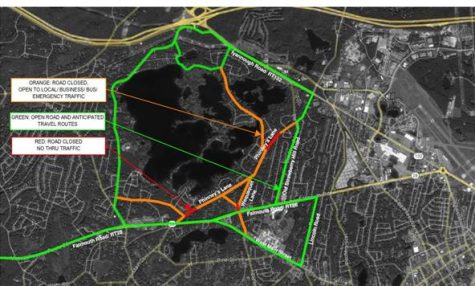Winds of Change
Environmental Problems Face The Cape
December 21, 2015
As the winter months roll in and bury Cape Cod in snow, it’s likely you will hear someone say something along the lines of “so much for global warming!” While this is a common joke, it is important to become and stay aware of Cape Cod’s changing environment.
Pilgrim Nuclear Power Plant
Designated as one of the top three least-safe nuclear reactors by the US Nuclear Regulatory Commission, the Pilgrim Nuclear Power Plant is set to shut down before 2020. The plant was built in 1972 in an effort to reduce Massachusetts’ carbon emissions. Since then, its function and safety have been questioned. Barnstable High School senior Raini Callahan conducted an extensive research project about the subject during her junior year. Callahan said, “its permit to dump waste and use the Cape Cod Bay as a cooling system has been expired for nearly 20 years; it’s killing our ecosystems and our economy by doing so.” The plant is now owned and operated by a Louisiana-based company called Entergy. Though the company is planning to shut it down in the upcoming years, “that does not mean we are safe. We still have four more years of an active power plant, and then who knows how long with a dormant one,” according to Callahan. Currently, the plant provides around 10% of the total energy use in Massachusetts. Callahan urged students who wish to learn more about the Plant to “stay aware of new developments and visit the website capedownwinders.org.”
Cape Wind
According to Barnstable High School environmental science teacher David Gorrill, “there is no easy answer” regarding the question to implement a wind farm in Nantucket Sound. While a wind farm as substantial as the one speculated by Cape Wind Associates will reduce carbon emissions by around 734,000 tons each year, other environmental and economic side effects are unknown. Gorrill said there are “many possible environmental changes” that could occur if the project were completed. He added that he is “not sure Nantucket Sound is the right place for a wind farm. Also, the technology used to construct the turbines continues to evolve– maybe we should wait another generation to truly understand the effects of turbine use in this setting.” Though construction was expected to begin during May 2015, the project has faced setbacks and permitting problems as well as strong public and political opposition at the local and federal level since it was originally proposed over 14 years ago. As of now, the proposed 130 turbines have not been placed in Nantucket Sound. To find out more about Cape Wind Associates, visit their website at capewind.org.
Erosion
Though erosion is a natural aspect of any coastal environment, the coastline along Cape Cod has been eroding at a rapid pace over the past century. NASA has tracked the coastline of Cape Cod for around 30 years and has found that the sea level is rising at about one foot per century; but this rate changes depending on other outside elements such as storms or severe climate changes. Gorrill said that “we [inhabitants of Cape Cod] have changed the shoreline with jetties and homes, but there aren’t really any ways we can stop the sea from rising.” One of the NASA researchers studying Cape Cod, Robert Oldale said, “erosion is only a peril to property. If we build on the shore, we must accept the fact that sooner or later coastal erosion will take the property away.” Though the coastline is receding at a rate faster than it has in the past, Cape Cod is not at risk of completely being swallowed by the ocean for around 5 or 6 thousand years, according to NASA.










